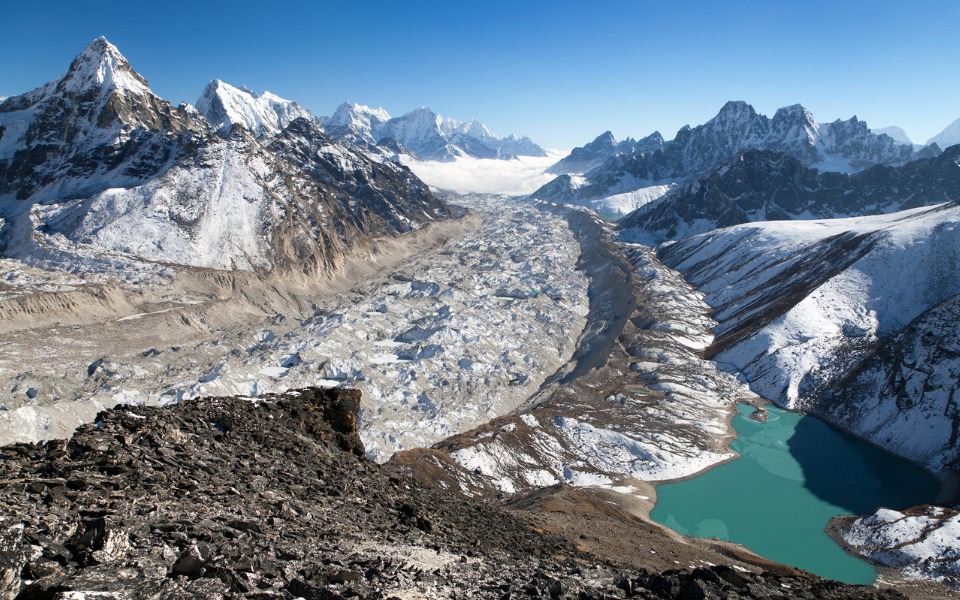
Himalayas to lose 75 per cent of snow by 2100 leading to eco disaster

A recent study has revealed that the rapidly melting glaciers in Asia’s Hindu Kush Himalayan region, known for having the world’s highest mountains, pose a severe threat to the lives and livelihoods of approximately two billion people residing downstream.
According to the International Centre for Integrated Mountain Development (ICIMOD) study, the glaciers in the Himalayan region have been thawing at a rate 65% faster during the period from 2011 to 2020 compared to the previous decade. If current emissions trends continue, it is estimated that these glaciers may lose 80% of their current volume by the end of the century.
Decline in permafrost
Furthermore, the study also highlights that the mountain ranges in the Hindu Kush Himalayan region, extending over a distance of 3,500 kilometres (2,175 miles) from Afghanistan in the west to Myanmar in the east, are experiencing a decline in permafrost.
Also Read: Rich over-emitting nations owe India $1,446 per capita until 2050 as compensation: Study
This shrinking permafrost increases the risk of landslides in the Himalayas. The ICIMOD, headquartered in Nepal and comprising eight member nations including China and India, provides this crucial insight into the environmental changes unfolding in the area.
Reduction in freshwater supplies
Consequently, this alarming trend could lead to a significant reduction in freshwater supplies across 12 rivers spanning 16 nations in the area.
Amina Maharjan, a migration specialist and co-author of the report, told Al Jazeera that the residents of these mountains, who have had minimal impact on global warming, face significant dangers as a result of climate change. ‘
Maharjan expressed deep concern over the inadequacy of current measures taken to adapt to these changes, and she insisted on the urgent need for enhanced support to ensure these communities can effectively handle the challenges they face.
Also Read: Why did Chandrayaan-2 fail? Corrections may help ISRO’s next moonshot, says report
Multiple previous studies have indicated that the cryosphere, encompassing areas of the Earth covered by snow and ice, is particularly susceptible to the adverse impacts of climate change.
These reports consistently highlight the cryosphere as one of the most severely affected regions, underlining the importance of addressing the issues specific to these areas in order to mitigate the consequences of global warming.
In recent research, it has been discovered that the glaciers of Mount Everest have experienced a staggering loss of ice equivalent to 2,000 years’ worth in just the last three decades.
Amina Maharjan highlighted the significance of mapping the connections between changes in the cryosphere and their impact on water resources, ecosystems, and society within this mountainous region.
This mapping provides crucial insights into understanding the far-reaching consequences of cryosphere changes in relation to the intricate interdependencies of water, ecosystems, and human communities in the area.
Also Read: US astrophysicists say NASA’s Kepler discovered a trio of exoplanet
According to the report, water flows in the 12 river basins of the Himalayan region, which include significant rivers such as the Ganges, Indus, and Mekong, are projected to reach their maximum levels by around the middle of this century.
This has critical implications for the more than 1.6 billion individuals who rely on these water sources for their needs.
Communities will be hit hard
Numerous communities residing in high mountain areas depend on glacial water and the melting of snow for agricultural irrigation. However, the timing of snowfall has become increasingly unpredictable, and the overall quantity of snow has diminished compared to previous years.
These changes pose significant challenges to these communities as they struggle to adapt to the evolving availability and reliability of water resources for their agricultural practices.
Amina Maharjan, pointed out the adverse impacts of changing climate patterns on mountain communities. She mentioned that these communities have experienced a significant increase in yak mortality during the summer season. The yaks, in search of higher pastures, face difficulties when snowfall occurs prematurely, covering the entire area and leaving no grass for them to graze on.
Also Read: Over 50 per cent of world’s largest lakes losing water: Study
As a consequence of these challenges, people from mountain communities are compelled to seek alternative sources of income outside their traditional habitats. This shift in population dynamics further underscores the gravity of the situation and the urgency for effective measures to mitigate the impacts of climate change on these vulnerable communities.


